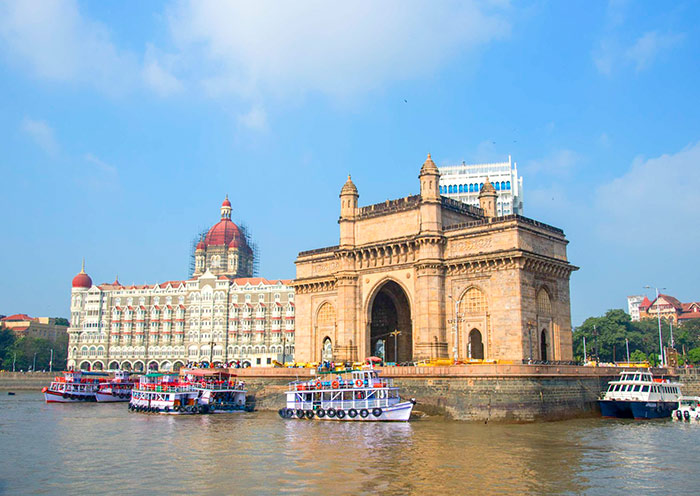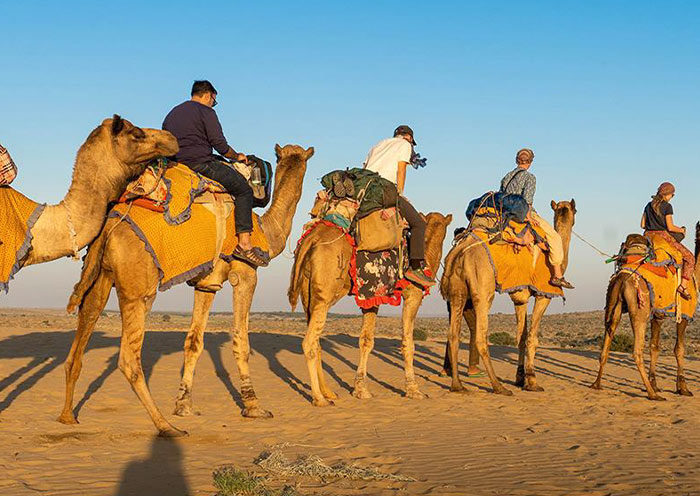Top Places to Visit in India & Nepal
India and Nepal offer a myriad of captivating destinations to explore. Here's an overview of some of the top places to visit in both countries with top attractions and suggested travel duration in each place.
| City | Top Attractions | Suggested Duration |
|---|---|---|
| Delhi, India | Red Fort, Jama Masjid, Humayun’s Tomb,Qutub Minar | 1-2 days |
| Agra, India | Taj Mahal, Agra Fort | 1 day |
| Jaipur, India | Amber Fort, City Palace, Hawa Mahal, Jantar Mantar | 1-2 days |
| Varanasi, India | Ganges River, Shri Kashi Vishwanath Temple | 1-2 days |
| Udaipur, India | City Palace, Jagdish Temple, Jagmandir Island Palace | 1 day |
| Jodhpur, India | Mehrangarh Fort, Jaswant Thada | 1 day |
| Mumbai, India | Gateway Of India, Elephanta Caves, Marine Drive,Dhobi Ghat, Victoria Terminus | 1-2 days |
| Goa, India | Basilica of Bom Jesus, Se Cathedral, beaches of Baga, Calangute, or Anjuna | 2-3 days |
| Kathmandu, Nepal | Kathmandu and Patan Durbar Squares, Monkey Temple, Boudhanath Stupa, Pashupatinath Temple, | 1-3 days |
| Pokhara, Nepal | Phewa Lake, Sarangkot, World Peace Pagoda | 1-2 days |
| Chitwan, Nepal | Chitwan National Park, Elephant Breeding Center | 1-2 days |
| Lumbini, Nepal | Lumbini Sacred Garden, Ashoka Pillar | 1 day |
| Nagarkot, Nepal | Sunrise and Sunset Views, Nagarkot View Tower | 1 day |
Please keep in mind that transportation times between two places can be lengthy, often taking 5-8 hours or more when traveling overland.

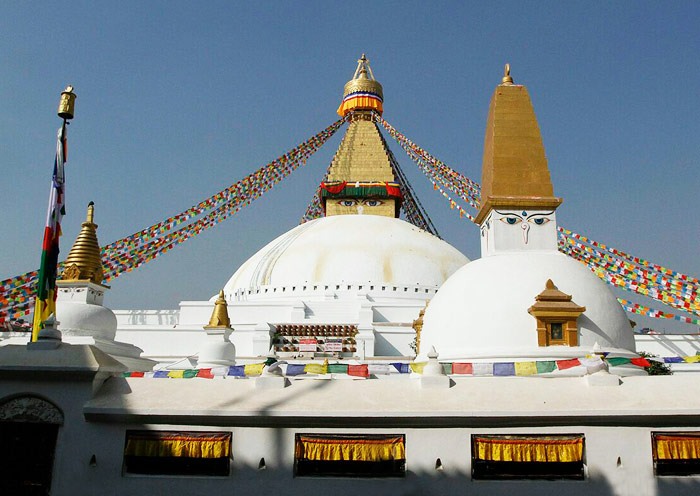
Best Things to Do in India & Nepal
India and Nepal offer a plethora of exciting activities and experiences for travelers.
Fun Things to Do in India
- Explore the Golden Triangle: Visit Delhi, Agra, and Jaipur to marvel at iconic landmarks like the Taj Mahal, Red Fort, Amer Fort, and enjoy the vibrant culture and cuisine of these cities.
- Spiritual Journeys: Experience the spiritual side of India by visiting Varanasi, where you can witness mesmerizing Ganga Aarti ceremonies and take a boat ride along the sacred Ganges River.
- Wildlife Safaris: Embark on thrilling wildlife safaris in national parks like Ranthambore, Bandhavgarh, and Kanha to spot majestic tigers, leopards, elephants, and other exotic animals.
Adventure Things to Do in Nepal
- Trekking in the Himalayas: Nepal is a trekking paradise, with famous trails like the Everest Base Camp Trek, Annapurna Circuit, and Langtang Valley Trek, offering stunning views of mountains, diverse landscapes, and cultural encounters with local communities.
- Adventure Sports: Engage in thrilling adventure activities like paragliding in Pokhara, white-water rafting in the Trishuli River, and bungee jumping in Bhote Koshi.
- Wildlife Encounters: Explore Chitwan and Bardia National Parks on jeep safaris, elephant-back rides, or jungle walks to spot rare wildlife species like tigers, rhinos, elephants, and various bird species.
- Cultural Immersion: Discover the rich cultural heritage of Nepal by exploring UNESCO World Heritage sites in Kathmandu, Bhaktapur, and Patan, visiting ancient temples, palaces, and monasteries.
- Spiritual Retreats: Seek spiritual solace by visiting sacred sites like Lumbini, the birthplace of Lord Buddha, and engaging in meditation and yoga retreats in peaceful settings.
Suggested Travel Length for India Nepal Tour
The suggested travel length for an India-Nepal tour depends on the depth of exploration you desire in each country. Here's an overview of the recommended travel lengths for a comprehensive tour:
India (1-2 Weeks)
To cover the major highlights of India, including the Golden Triangle (Delhi, Agra, Jaipur), as well as other popular destinations like Varanasi, Mumbai, and Rajasthan, a minimum of 1 to 2 weeks is recommended. This duration allows for a well-rounded experience, with ample time to explore historical sites, immerse in local culture, and enjoy diverse landscapes.
Nepal (4-10 Days)
To fully appreciate Nepal's natural beauty, cultural heritage, and trekking opportunities, a minimum of 4 to 10 days is suggested. This duration allows for visiting Kathmandu and its UNESCO World Heritage sites, exploring Pokhara and enjoying activities like trekking or boating on Phewa Lake, and venturing into national parks like Chitwan for wildlife encounters.
Combined India-Nepal Tour (10-20 Days)
For a comprehensive tour that includes both India and Nepal, a suggested travel length of 10 to 20 days ideal. This timeframe allows for a well-paced exploration of both countries, including the major highlights mentioned earlier. It provides ample time to delve into the rich cultural heritage, visit iconic landmarks, experience spiritual traditions, engage in adventure activities, and enjoy the natural landscapes of both India and Nepal.
Of course, these suggested travel lengths can be customized based on your specific interests and available time. It's important to consider factors such as transportation logistics, visa requirements, and seasonal variations while planning your itinerary.


Best India Nepal Itinerary for 2 Weeks
According to the suggested travel length and suggested city duration mentioned above, a tour to both India and Nepal will take at least 1 week for only 2 or 3 destinations. If you want to explore the best and classical sites in these two countries, you’d better plan a 2-week itinerary for this dreamy journey.
Here is one highly recommend India Nepal 12-day itinerary for first timers, especially these travelling with friends and families.
Day 1: Arrive in Delhi, India
Day 2: Delhi Sightseeing (Jama Masjid, Chandni Chowk, India Gate, Qutub Minar, Humayun's Tomb)
Day 3: Drive to Agra from Delhi (5 hours)
Day 4: Agra Sightseeing (Taj Mahal, Agra Fort, Baby Taj)
Day 5: Drive to Jaipur from Agra (5 hours)
Day 6: Jaipur Sightseeing (Amber Fort, City Palace, Hawa Mahal, Jantar Mantar)
Day 7: Drive to Udaipur from Jaipur (6 hours)
Day 8: Udaipur sightseeing (City Palace, Jagdish Temple, Jagmandir Island Palace)
Day 9: Take a connecting flights from Udaipur to Kathmandu via Delhi.
Day 10: Kathmandu Sightseeing (Kathmandu Durbar Squares, Monkey Temple, Boudhanath Stupa) then Drive to Nagarkot for sunset (1 hour).
Day 11: After sunrise in Nagarkot drive back to Kathmandu (Pashupatinath Temple) via Bhaktapur Durbar Squares
Day 12: Depart from Kathmandu
Extend Your India Nepal Tour
If you have more time and wish to extend your South Asia journey beyond India and Nepal, exploring Bhutan, Tibet, or mainland China can offer unique cultural and natural experiences. Here's an overview of the general travel duration for each destination:
Bhutan (4-10 days):
Bhutan, known as the "Land of the Thunder Dragon," offers a mystical and unspoiled environment. To truly experience the country's beauty and immerse yourself in its culture, it is recommended to spend at least 4 to 10 days in Bhutan. This allows for visits to popular destinations like Thimphu (the capital city), Paro (home to the famous Tiger's Nest monastery), Punakha (with its stunning dzong), and other scenic valleys.
Tibet (4-10 days):
Tibet, often referred to as the "Roof of the World," is renowned for its spiritual heritage and breathtaking landscapes. To acclimatize to the high altitude and fully appreciate the region, a minimum of 4 to 10 days is recommended. This duration allows for exploring Lhasa (the capital city) with its iconic Potala Palace and Jokhang Temple, as well as visiting other significant sites like Namtso Lake, Yamdrok Lake, and the Everest Base Camp.
Mainland China (6-14 days):
Mainland China offers an array of diverse destinations, from bustling cities to ancient landmarks and picturesque landscapes. Depending on the specific places you wish to visit, a recommended duration would be around 6 to 14 days. This allows for exploring popular destinations like Beijing (the capital), Shanghai, Xi'an (home of the Terracotta Warriors), Chengdu (known for pandas), Guilin (famous for its scenic karst mountains), and the Yangtze River.

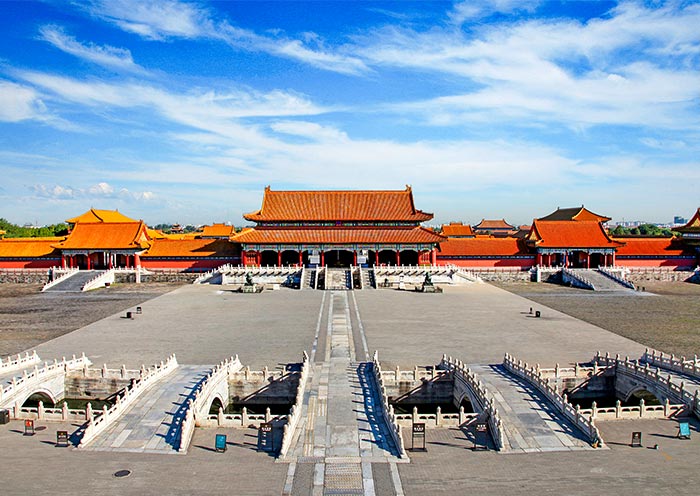
Best Time to Visit India & Nepal Together
The best time to visit India and Nepal together largely depends on the specific regions and activities you plan to engage in. The best time to visit India (Golden Triangle) is during the winter months, from October to March, when the weather is generally pleasant across most parts of the country. For Nepal, the best time to visit is during the spring (March to May) and autumn (September to November) seasons. Considering both countries, the best time to visit India and Nepal together would be during the overlapping months of October and November or February and March.
In October and November, the weather in India is typically mild and comfortable. The monsoon season has ended, and temperatures start to cool down. It's an ideal time for outdoor activities and sightseeing. You can explore historical sites, enjoy cultural events, and indulge in outdoor experiences with ease. October and November are considered the peak tourist season in Nepal. The weather during these months is characterized by clear skies and mild temperatures. It's an excellent time for trekking in the Himalayas. The views of the mountains are often spectacular, and the weather conditions are favorable for outdoor adventures.
In February and March, the weather in both countries is transitioning from winter to spring. The weather in India starts to warm up, and the temperatures are generally pleasant across most regions. It's a good time to visit destinations like Delhi, Agra, and Rajasthan, as the weather is comfortable for outdoor exploration and sightseeing. The weather in Nepal gradually becomes warmer. While it may still be chilly in the mornings and evenings, the daytime temperatures are pleasant. It's a great time to visit Kathmandu, Pokhara, and other cultural sites.
How to Apply for India and Nepal Visa?
Preparing for a grand escapade through the mystical lands of India and Nepal? Let's unravel the tapestry of visa applications, ensuring you step onto these ancient soils with ease.
India Visa: The E-Visa Ease
Applying for an Indian visa is now a streamlined and convenient process with the introduction of the e-Visa system. Most travelers can apply online for an e-Visa, saving time and effort. Simply visit the official e-Visa portal, complete the application form, and upload the necessary documents.
The e-Visa approval is typically delivered via email within a few days, granting you access to your Indian adventure. It's recommended to apply at least four days before your intended travel date, but no more than 120 days in advance. With just a few clicks, you can embark on your journey to India, enjoying the digital ease and efficiency of the e-Visa system.
Nepal Visa
Applying for a visa to Nepal is a relatively straightforward process. Depending on your nationality and travel plans, you can choose to apply for a visa in advance at a Nepalese embassy or consulate, or you can obtain a visa on arrival at major entry points in Nepal.
If you choose to apply in advance, visit the official website of the Department of Immigration, Nepal, and fill out the online visa application form. Provide accurate details and upload the required documents. Once submitted, pay the visa fee either at the embassy/consulate or upon arrival in Nepal.
For visa on arrival, you can obtain the application form at the entry points or download it from the official website in advance. Fill out the form, attach a passport-sized photograph, and pay the visa fee in cash or using accepted payment methods.
Trust Asia Odyssey Travel to effortlessly manage your visa and craft personalized itineraries for Tibet, Nepal, and India. Focus on the adventure; we'll take care of the details. Contact us now for a seamless travel experience!


Cost of Your India Nepal Tours
On average, for a budget-conscious traveler in India and Nepal, daily expenses can range from $50 to $100 per person. This would typically cover basic accommodation in budget hotels or guesthouses, local transportation using public buses or trains, meals at local eateries or street food stalls, and visits to affordable attractions and activities.
For mid-range travelers looking for more comfort and convenience, daily expenses can range from $100 to $200 per person. This would include accommodation in mid-range hotels or guesthouses, transportation options such as private taxis or hired vehicles, dining at restaurants offering a variety of cuisines, and visits to popular attractions and activities.
For luxury travelers seeking upscale experiences, daily expenses can exceed $200 per person. This would involve luxurious accommodation in high-end hotels or resorts, private transportation with chauffeurs, fine dining at upscale restaurants, and exclusive activities and experiences.
To manage costs, budget-conscious travelers can explore options like group tours organized by travel agencies. Especially in Nepal, group tours often offer cost-saving benefits. Additionally, travel agencies can assist with arranging flights, layovers, and other logistical matters, saving you time and effort in planning. Reach out to renowned travel experts at Asia Odyssey Travel specializing in the Himalayan region for personalized assistance.
Which Country Starts Your India and Nepal Trip
Both India and Nepal offer convenient entry points, and you can choose the country that suits your itinerary.
If you plan to spend more time in amazing India, it is common to start your trip in India. Major international airports in India, such as Delhi, Mumbai, and Kolkata, serve as popular entry points for travelers. You can begin your journey in Delhi or Mumbai and then make your way to various destinations in India, such as the Golden Triangle (Delhi, Agra, Jaipur), Rajasthan, Amritsar, or Varanasi, before crossing the border into Nepal.
On the other hand, if your primary focus is on exploring Nepal and you intend to spend more time there, you can start your trip in Nepal. The Tribhuvan International Airport in Kathmandu is the main international airport in Nepal and serves as the common entry point for most visitors. From Kathmandu, you can explore the capital city, visit UNESCO World Heritage Sites, embark on treks in the Himalayas, or venture to other regions of Nepal.
How to Travel Between India and Nepal
Traveling between India and Nepal is relatively convenient, and there are several options available for transportation depending on your preferences and budget.
By Air:
The quickest and most convenient way to travel between India and Nepal is by air. Direct flights between major cities in India (such as Delhi, Mumbai, and Kolkata) and Kathmandu, the capital of Nepal, have a flight duration of approximately 1 to 2 hours.
By Road:
If you prefer overland travel, you can cross the India-Nepal border via road. There are several border crossings between the two countries, including the Sunauli-Bhairahawa border, Raxaul-Birgunj border, and the Panitanki-Kakarbhitta border. The road journey from these border towns to Kathmandu can take anywhere from 6 to 12 hours, depending on the distance and road conditions. However, it's important to check the visa requirements and any necessary permits for crossing the border, as well as the current condition of the roads and border crossings.
It's important to check the visa requirements, border regulations, and any travel advisories before planning your journey between India and Nepal. Consider the time, cost, and convenience factors when choosing the mode of transportation that best suits your travel needs.


Where to Stay During India and Nepal Tour?
Recommended places to stay in India
In Delhi, you'll find a wide range of accommodation options to suit various budgets and preferences. Popular areas to stay in Delhi include Connaught Place, Karol Bagh, Paharganj, and South Delhi. These areas offer a mix of luxury hotels, mid-range hotels, and budget guesthouses or hostels.
Agra:
Agra is known for the iconic Taj Mahal. It's recommended to stay near the Taj Mahal complex for convenient access. The Taj Ganj area is a popular choice as it is within walking distance of the Taj Mahal. You'll find a range of hotels and guesthouses in this area catering to different budgets.
Jaipur, the capital of Rajasthan, offers a variety of accommodation options. The old city area, known as the Pink City, is a popular choice for its historical charm. Other areas like MI Road and Civil Lines also have a good selection of hotels. From luxurious heritage hotels to budget-friendly guesthouses, Jaipur has something for every traveler.
Recommended places to stay in Nepal:
Kathmandu, the capital of Nepal, has a wide range of accommodation options catering to different budgets. Thamel is the main tourist hub and offers a plethora of guesthouses, hotels, and backpacker accommodations. Other areas like Boudha and Lazimpat also have a good selection of hotels.
Chitwan:
Chitwan National Park, known for its wildlife and jungle safaris, offers various accommodation options ranging from luxury resorts to budget lodges. Sauraha is the main gateway to Chitwan National Park and has a wide range of hotels and lodges catering to different budgets. Staying in Sauraha provides easy access to the national park and its activities.
Pokhara:
Pokhara, a beautiful lakeside town in Nepal, offers stunning views of the Himalayas and outdoor activities. Lakeside is the main area for accommodation in Pokhara, with a wide range of hotels, guesthouses, and resorts along the lakeshore. This area is popular among travelers for its scenic setting and proximity to Lake Phewa.
What to Eat During India and Nepal Trip?
Both India and Nepal offer a wide range of regional cuisines and local specialties, so make sure to explore the diverse culinary delights in each destination. Don't forget to try street food options, as they provide a glimpse into the vibrant food culture of these countries.
Recommended Dishes in India:
- Butter Chicken: Succulent chicken cooked in a rich and creamy tomato-based gravy.
- Biryani: Fragrant rice dish with layers of meat, such as chicken, mutton, or fish, cooked with aromatic spices.
- Masala Dosa: Crispy rice and lentil crepe filled with a spiced potato filling, typically served with chutneys and sambar.
- Chole Bhature: A popular North Indian dish consisting of spicy chickpea curry (chole) served with deep-fried bread (bhature).
- Rogan Josh: A flavorful Kashmiri lamb curry cooked with a blend of aromatic spices.
- Pav Bhaji: A Mumbai street food specialty featuring a spicy vegetable curry (bhaji) served with buttered bread rolls (pav).
- Golgappe/Pani Puri: A popular street food snack consisting of hollow crispy puris filled with spicy tangy water and various fillings.
Recommended Dishes in Nepal:
- Momos: Dumplings filled with meat or vegetables, served with spicy dipping sauce.
- Dal Bhat: The staple dish of Nepal, consisting of lentil soup (dal) and steamed rice (bhat), often accompanied by vegetables, pickles, and curries.
- Newari Cuisine: Try traditional Newari dishes like Yomari (sweet rice flour dumplings), Choila (marinated grilled meat), and Samay Baji (a platter of beaten rice, black soybeans, meat, and other condiments).
- Sel Roti: A sweet and crispy ring-shaped rice flour bread, often enjoyed during festivals and special occasions.
- Thakali Cuisine: Sample dishes like Dhindo (a traditional cornmeal dish), Kodo Ko Roti (millet bread), and Thakali Thali (a platter with a variety of curries, rice, and lentils).
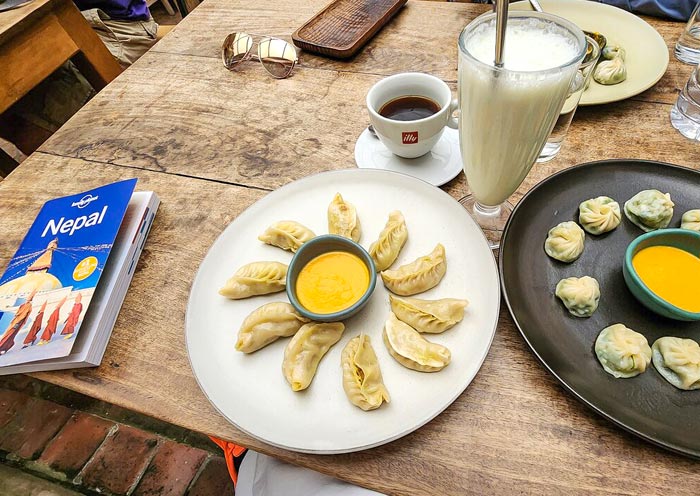
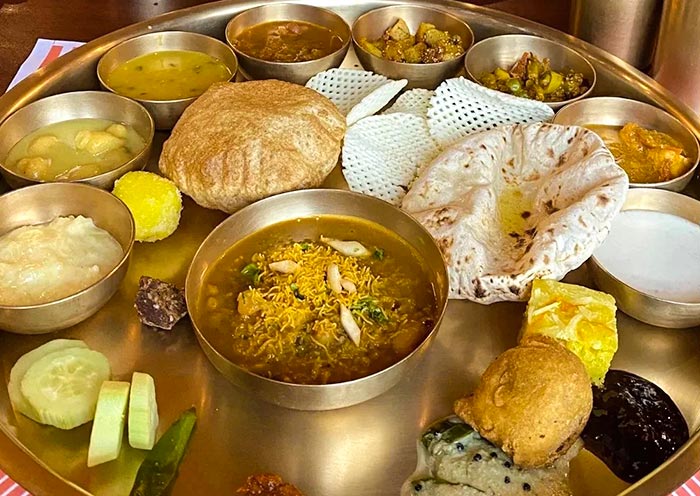
If you have any questions about this article, please contact us by submitting the following form and we'll immediately get back to you.



